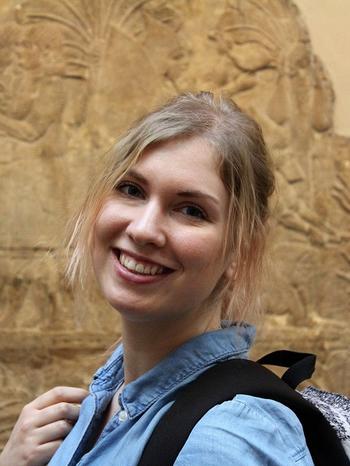Mette Bangsborg Thuesen M.A.

Languages and Cultures of the Silk Road (Silk Road)
Vorderasiatische Archäologie
Institut für Vorderasiatische Archäologie
Fabeckstr. 23-25
14195 Berlin
08/2018 – 09/2019
Trench supervisor for two work seasons at Tapeh Kheibar, Iran. Joint Danish-Iranian project directed by Razi University and University of Copenhagen
08/2018 – 02/2019
Research assistant on the Heritage and Threat (HeAT) project, University of Copenhagen
07/2018 – 08/2018
Excavator for one work season at Ganj Dareh, Iran. Joint Danish-Iranian project directed by Razi University and University of Copenhagen
04/2018 – 06/2019
Excavator and small finds specialist for two fieldwork seasons at Shubayqa, Jordan. Project directed by University of Copenhagen
08/2016 – 02/2017
Erasmus Exchange student at Freie Universität Berlin
01/2016 – 04/2016
Intern at the Ethnographical Collection, National Museum of Denmark
09/2015 – 01/2018
Master degree in Near Eastern Archaeology, University of Copenhagen
09/2015 – 01/2016
Teaching Assistant, University of Copenhage. Introduction course to Mesopotamian Archaeology
06/2015 – 08/2016
Excavator for two work seasons at Sannai Maruyama Archaeological Site, Japan
seit 08/2014
Excavator and small finds specialist for four seasons at archaeological site of Shkaret Msaied, Jordan. Project directed by University of Copenhagen
05/2014 – 05/2017
Trench supervisor for two work seasons at Kurd Qaburstan, Iraq Kurdistan. Project directed by John's Hopkins University
02/2013 – 12/2014
Research Assistant on the Diana Kirkbride Archieve, University of Copenhagen
09/2012 – 01/2015
Bachelor degree in Near Eastern Archaeology, University of Copenhagen
Defining cultural boundaries on the Silk Road – a Sasanian pottery assemblage from North Eastern Iran
The Sasanian Empire (225-640 C.E.) was one of the most influential dynasties in the ancient world and as the “Middle Kingdom” between Rome and China, its cultural and economic influence was felt throughout the Silk Road. Yet this important epoch is not as well understood due to the lack of historical records and the general absence of archaeological interest.
What generally characterises the ceramic traditions during the Sasanian period is that pottery is highly regionalised, which has complicated the making of a general typology. This dissertation will therefore look into how these regional differences in ceramic traditions might relate to different usage and consumption traditions within the empire. It will furthermore explore how cultural similarities and differences materialise through pottery and food production, by using the pottery assemblage from Tappeh Rivi as a case study on commensality and cultural exchange along the Silk Roads and how this fluctuated with changes in the political situation and international commerce during the Sasanian period.
In preparation
Social Evolutionary Narratives of Early Craft Specialisation in the Levant (Co-author Tobias Richter)
The Fox - A tale from Neolithic Shkaret Msaied (co-authors: Moritz Kinzel, Konrad Nuka Godtfredsen and Bo Dahl Hermansen)
In press
Ved Asiens porte - udgravninger på Tapeh Kheibar, en oldtidshøj i Zagrosbjergene, Sfinx
2018
Stone Beads from Shkārat Msaied, Neo-lithics 1/18 (co-author Moritz Kinzel)
Conflict & Culture: Understanding Threats to Culture Heritage (as co-editor)
2017
Irakisk Kurdistan – et arkæologisk Mekka, Sfinx Vol. 40 No. 4
2016
Shkārat Msaied 2016: New Results from Unit F, Neo-Lithics 1/17. Pp: 13-17 (as co-author)
Gertude Bell – Ørkenens Dronning, Sfinx 39/1 Pp: 17-21
2015
Shkārat Msaied, the 2014 and 2015 Seasons, Neo-lithics 2/15. Pp: 3-10 (as co-author)
